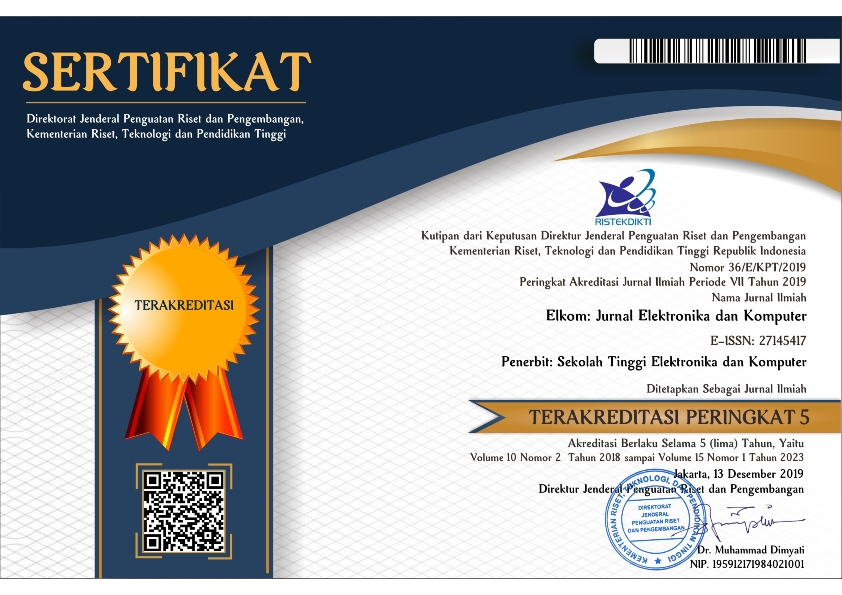SISTEM PENILAIAN KINERJA TENAGA PENDIDIK DAN TENAGA KEPENDIDIKAN BERBASIS WEB DI STEKOM SEMARANG
Abstract
STEKOM College which has branch campuses in several places. Employee performance appraisals are carried out by superiors and branch campus coordinators using Ms. Excel. The results of the performance assessment are sent to the staffing department via e-mail. The personnel department will recap the results of the performance appraisal to be conveyed to the leadership. This assessment process takes a long time and tends to be inefficient. In this study, a web-based Employee Performance Appraisal System was developed that can be accessed online by relevant appraisers at the central campus and STEKOM branch campuses. The System Development Method uses a Research and Development (R&D) approach. Assessment elements include 6 (six) aspects, namely: Service Orientation, Integrity, Commitment, Discipline, Cooperation and Leadership. The results of the performance appraisal of educators (lecturers) apart from being used internally as a measurement of lecturers' work behavior, can also be used externally for the assessment of work behavior when the lecturer makes Employee Performance Targets (SKP), as well as being used to assess the performance of education personnel. System modeling uses the Unified Modeling Language (UML). Making the source code program using the Hypertext Preprocessor (PHP) programming language with a web-based MySQL database using Notepad ++ software. The results obtained from the use of the employee performance appraisal system, performance reports can be obtained more quickly, making it easier for the staffing department to obtain data on employee performance appraisals effectively and efficiently.
References
YAN ILMAS PUIMERA and Danang Danang, “RANCANG BANGUN ALAT PENYORTIRAN BARANG OTOMATIS BERBASIS ARDUINO PADA PT WAHANA PRESTASI LOGISTIK SEMARANG”, ELKOM, vol. 11, no. 1, pp. 38-44, Jul. 2018.
Rasminto, Hendri, & Danang, D. (2018). IMPLEMENTASI WEBSITE SEBAGAI MEDIA PROMOSI DAN INFORMASI PADA MAX Team OUTBOUND TRAINING UNTUK MEMUDAHKAN DAN MENINGKATKAN DAYA TARIK PELANGGAN . JURNAL TEKNOLOGI INFORMASI DAN KOMUNIKASI, 9(2), 25-36. https://doi.org/10.51903/jtikp.v9i2.155
G. Gufron and D. Danang, “SISTEM PAKAR PENANGANAN KERUSAKAN KOMPUTER DAN PERIPHERALNYA”, ELKOM, vol. 11, no. 2, pp. 29-42, Dec. 2018.
Eni Dwifitri Astutiningtias, & Danang Danang. (2018). DESAIN WEB SEBAGAI MEDIA PROMOSI DAN INFORMASI PADA RAFI STAMP SEMARANG . Pixel :Jurnal Ilmiah Komputer Grafis, 11(2), 13-22. Retrieved from https://journal.stekom.ac.id/index.php/pixel/article/view/64
Danang Danang, & Fatimah Indrawati. (2018). PENGEMBANGAN SISTEM PERSEDIAAN BARANG BERBASIS MULTIUSER DI PT. SAI APPAREL INDUSTRIES SEMARANG. Kompak :Jurnal Ilmiah Komputerisasi Akuntansi , 11(2), 45-52. https://doi.org/10.51903/kompak.v11i2.47
Andik Susdiyanto, & Danang Danang. (2018). SISTEM INFORMASI PENJUALAN SECARA ONLINE (Studi Kasus Pada CV. Java Mini Semarang). Kompak :Jurnal Ilmiah Komputerisasi Akuntansi , 11(2), 21-32. https://doi.org/10.51903/kompak.v11i2.45
Danang Danang and Siswanto Siswanto, “KONSEP PENGENDALI LAMPU PENERANGAN RUMAH DARI JARAK JAUH MENGGUNAKAN GELOMBANG FREKUENSI”, ELKOM, vol. 12, no. 2, pp. 34-49, Dec. 2019.
Suwardi Suwardi, & Danang, D. (2019). Sistem Informasi Persediaan Oli Dengan Metode ROP di CV. Sumber Lumas Semarang. JURNAL TEKNOLOGI INFORMASI DAN KOMUNIKASI, 10(2), 1-8. https://doi.org/10.51903/jtikp.v10i2.129
D. Danang, S. Suwardi, and I. A. Hidayat, "Flood Disaster Mitigation Using a Disaster Early Warning and Monitoring Information System with an IoT-Based Arduino Microcontroller," TEKNIK, vol. 40, no. 1, pp. 55-62, May. 2019. https://doi.org/10.14710/teknik.v40i1.23342














